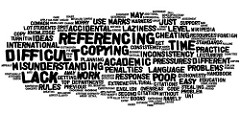School of Mathematical Sciences UG Student Handbook 2024/25
QMplus version
Recommended Referencing Style

This guidance is about how to reference published work such as books and research articles in documents such as project reports. You should follow the recommendation below unless you have a good reason not to (such as being given different instructions by your module organiser). There is no single referencing style used preferentially within the mathematical sciences literature.
Referencing
Different publications use different referencing styles; you should choose one and use it consistently. What is most important is to provide enough information that the reader can find the document you are referencing. You must always include the author and document title, and you must include the publication date of a printed document and the date when you last accessed an online document. See the next chapter for more specific guidance on referencing.
Recommendation
You should use either the Harvard (author, date) or Vancouver (numerical citation) referencing style, as described below. If your module organiser does not tell you which to use then you can choose. Queen Mary Library will only offer support for these two referencing styles, so if you wish to seek advice from the library then you must conform to one of these styles. Both styles are used below as illustrations, although you must use only one referencing style consistently throughout any one document.
Harvard referencing style
Originating at Harvard University within the discipline of Biology during the late 19th Century, Harvard referencing is widely accepted in a broad range of scientific publications. The Harvard system’s "author, date" method helps to ensure a reader familiar with a particular field is likely to recognize a citation without having to check in the references section. This characteristic is particularly helpful within scientific disciplines whose works are commonly known by their date of publication.
Vancouver referencing style
The Vancouver referencing system is a numeric citation system used in biomedical, health and science publications. It was first defined in 1978 at the conference of the International Committee of Medical Journal Editors (ICMJE) in Vancouver, Canada, hence its name. It is also known as the Uniform Requirements for Manuscripts Submitted to Biomedical Journals. It is used extensively in the physical sciences.
Guidance
You should use the version of the Harvard or Vancouver style applied by the guide to referencing, Cite Them Right (Pears and Shields, 2016), which is currently available from QMUL Library in print format. It offers a standard and up-to-date source for constructing citations and references in the Harvard and Vancouver referencing styles. Cite Them Right (1) also provides guidance on referencing and citation more generally, including how to avoid plagiarism. See also Find It! Use It! Reference It!.
However, we advise you to use Cite Them Right Online, which contains clear guidance on the Harvard and Vancouver referencing styles.
- You can choose a source to reference from a drop-down menu or by using the search facility.
- Cite Them Right Online shows you how to create the reference in the style you need.
- There are examples to copy, and a 'You try' box so you can build your reference on screen.
- You can check these against a correct example.
- You can then export the prepared reference straight into your coursework.
Acknowledgement
This document is based on one written by
| Martin BeesonLibrary Teaching and Learning Support ManagerStudent Services | Sally MitchellHead of Learning DevelopmentStudent Services |
References
Harvard-style reference
Pears, R. and Shields, G. J. (2016) Cite them right: The essential referencing guide. 10th ed.Basingstoke: Palgrave Macmillan.
Vancouver-style reference
- Pears R, Shields GJ. Cite them right: The essential referencing guide. 10th ed. Basingstoke:Palgrave Macmillan; 2016.